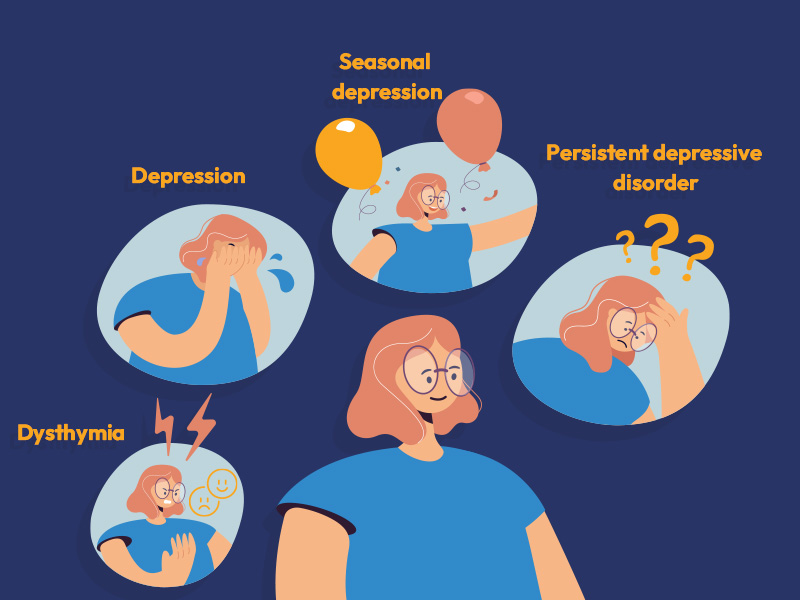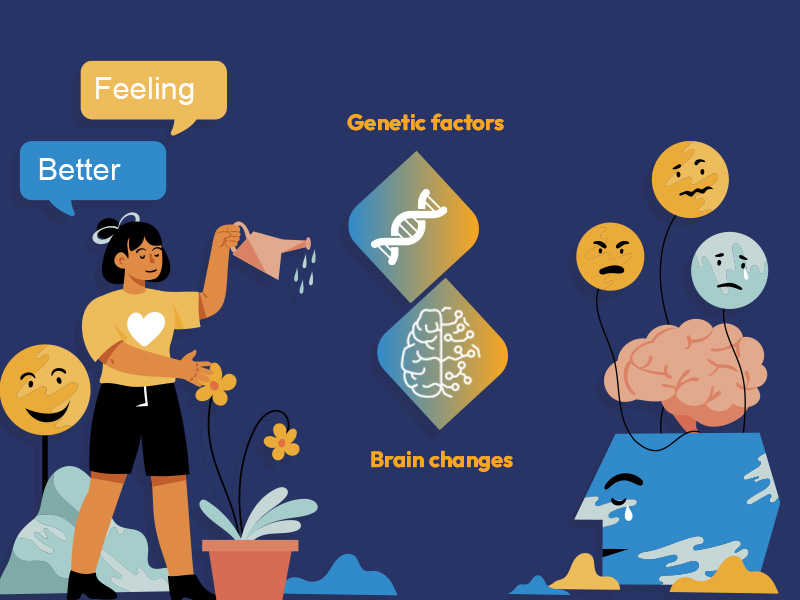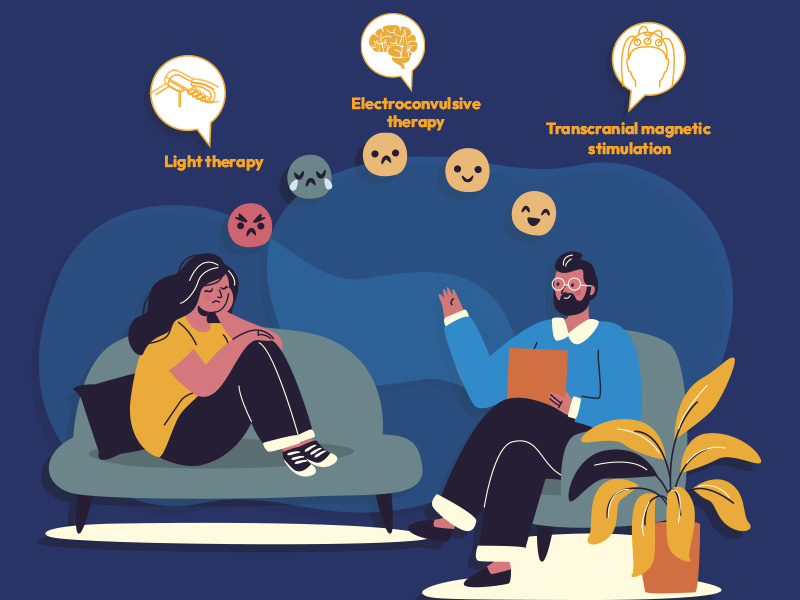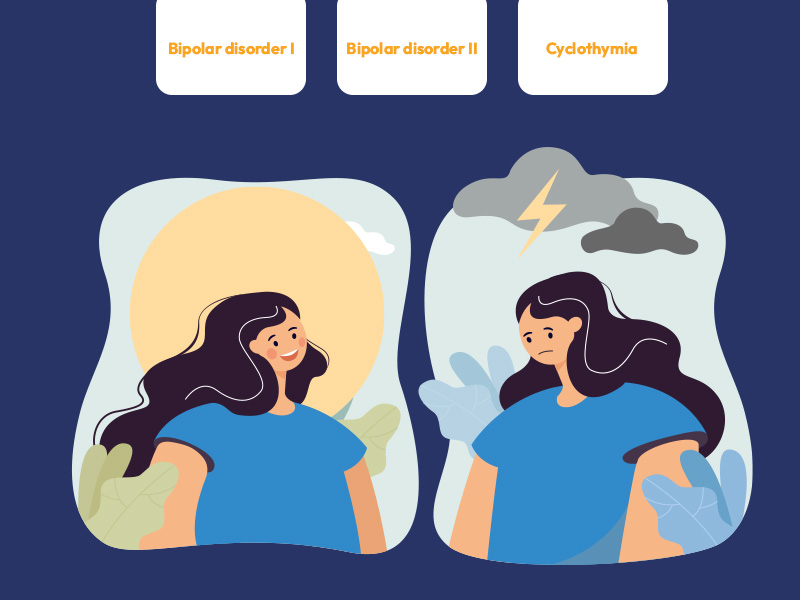
Mood Disorders: Types, Symptoms & Treatment
Mood disorders are common mental health issues that involve a prolonged phase of sadness and decreased energy levels. Affected individuals do not feel any connection between their thoughts, emotions, and the real world present around them. If you want to know more about what mood disorders are and what the common symptoms are, then this article is the best option for you. With the help of this article, you will also understand the different types of mood disorders and treatments.
What is a Mood disorder?
Mood disorder is a type of mental illness that affects the mental state of individuals. Affected individuals do not have control over their thoughts. Their emotional state gets disturbed, and they face difficulty in functioning in normal life.
Getting sad or experiencing a change in mood and emotions for a specific period is quite normal. However, in mood disorders, the sadness persists for a longer period, and individuals do not feel happiness in anything. In addition, they also experience major anger issues. Any individual can suffer from mood disorders, including children, adolescents as well as adults. However, there is diversity in the extent of the symptoms of both children and adults. Overall, mood disorders make their life difficult, and they face multiple complexities in their both personal and professional life.
However, fortunately, mood disorders are treatable with the help of medications, psychotherapy and effective preventive strategies. Whenever you feel that your depressive symptoms are getting prolonged, then you need to immediately consult mental health experts for professional assistance.
What are the types of Mood disorders?
There are different types of mood disorders, but the most common ones are as follows:
1. Depression
There are different names for depression such as major depression and clinical depression. Depression is a common mental health disorder that results in persistent depressive thoughts. Depressed individuals feel hopeless, and they think that they are not capable of doing anything in their life. They cannot think effectively, and their distorted thought patterns also affect their behaviour. Moreover, they prefer to stay alone and avoid interacting with others. They do not take an interest in those activities that were once enjoyable for them. If your symptoms are from approximately two weeks or more, then you are the victim of depression.
2. Persistent depressive disorder
This type of depression usually lasts for a longer period. Feelings of sadness, emptiness and a sense of worthlessness are some of the common symptoms of persistent depressive disorder. Although this depression type is chronic, the symptoms are less severe as compared to the clinical or major depressive disorder. Moreover, the severity of symptoms also gets reduced with time.
3. Seasonal depression
As the term indicates, this type of depression occurs in a specific season such as late autumn or early winter. Most of the individuals get the symptoms of seasonal depression during these seasons. However, when the season ends, symptoms also disappear. Individuals rarely get seasonal depression during the summer or spring, as most individuals feel happiness in these two seasons.

4. Postpartum and prenatal depression
Most females experience depression during pregnancy. If the symptoms of depression appear during the pregnancy, then it is referred to as prenatal or peripartum depression. However, if the depression occurs after childbirth, then it is called postpartum depression. Both types of depression not only affects the female but also the baby and loved ones. Environmental stressors and emotional and hormonal imbalances are the major causes of prenatal and postpartum depression.
5. Psychotic depression
In this type of depression, symptoms of depression are linked with psychosis. Affected individuals face difficulty in staying and believing in reality as they remain lost in their thoughts. Hallucinations, delusions, disorganised thinking patterns and the resulting negative behaviour are some of the common symptoms of psychotic depression.
6. Dysthymia
Dysthymic condition is also a type of depression that involves the occurrence of depressive thoughts and irritable behaviour. Moreover, the symptoms also last for about two years.
7. Disruptive mood dysregulation disorder
This depression is common in children and adolescents. Affected individuals exhibit anger outbursts more often than normal children and teenagers. Moreover, they do not show positive behaviour due to their emotional fluctuations.
8. Bipolar disorder
Bipolar disorder is also a major type of mood disorder. This involves unusual shifts in mood and energy levels. Due to their mood swings, they do not handle their relationships and essential life activities. At one time, they feel extreme happiness, pleasure, contentment and high energy levels. While at any other time, they feel extreme sadness, hopelessness and decreased energy levels. These two episodes are referred to as manic and depressive episodes. In some cases, both phases occur at the same time, which is called a mixed episode.
Types of Bipolar disorder
There are two different types of bipolar disorder, which are as follows:
1. Bipolar disorder I
This type of bipolar disorder involves one or multiple manic episodes. In some individuals, depressive symptoms also appear but are not considered essential for diagnosis.
2. Bipolar disorder II
Bipolar disorder involves the depressive episode and some symptoms of hypomania, which are less severe as compared to the manic episode. Moreover, symptoms of hypomania also persist for weeks but usually do not affect the functioning ability.
3. Cyclothymia
Cyclothymic condition is another type of bipolar disorder, but it is less common among other types. Individuals with cyclothymia also experience emotional fluctuations. In addition, they also experience the symptoms of mild depression and hypomania for a longer period.
Is anxiety a mood disorder?
No, Anxiety is not referred to as a mood disorder. However, it is categorized among anxiety disorders, which include panic disorders and phobias. In some cases, anxiety also occurs as a co-occurring disorder with mood disorders.
Who is affected by Mood disorders?
Children, teenagers and adults can get the symptoms of mood disorders. Although there is a great resemblance between the symptoms, still there is diversity in the severity of symptoms.
How common are mood disorders?
Mood disorders are undoubtedly one of the common mental health issues. Among them, depressive disorders and bipolar disorders are most common. Moreover, it is estimated that approximately 7% to 8% of individuals suffer from depression, while the ratio of individuals who suffer from the disorder is 2.8%. Likewise, the ratio also varies in both children and adults.
What are the symptoms of Mood disorders?
Each exhibits the following symptoms, which exhibit diversity based on the type of mood disorder.
Symptoms of Depressive disorders
Some common symptoms of depressive disorders are as follows:
- Feelings of sadness
- Emptiness
- Lack of passion or interest
- Reduced pleasure
- Decreased energy levels
- Feelings of worthlessness
- Eating abnormalities
- Issues in the sleep-wake cycle
- Difficulty in focus or concentration
- Intrusive thoughts
Symptoms of Bipolar disorder
In the case of bipolar disorder, the following symptoms are more common:
- Emotional fluctuations
- Difficulty in speech
- Irritable behavior
- Extreme levels of energy
- Hyperactive or impulsive behaviour
- Racing thoughts
Who is at risk for Mood disorders?
Anyone can get sad due to any unexpected situation. However, mood disorders are more intense and affect the person’s life. Moreover, if the symptoms are left untreated, they can last longer. Any internal or environmental stress factor can result in mood disorders. Moreover, all individuals, including children, adolescents as well as adults, can get suffer from mood disorders.
However, children and teenagers are more susceptible to being affected by mood disorders. Likewise, different studies have reported that females are at more risk of suffering from anxiety, depression and all types of mood disorders. However, males usually do not consider their mental situation, and therefore, their symptoms are mostly misdiagnosed or underdiagnosed.
What are the causes of Mood disorders?
There is not a single cause of mood disorders. Multiple causes are responsible for the development of mood disorders, which include:
1. Brain changes
The amygdala and orbitofrontal cortex are the two main regions of the brain which control emotions and mood alterations. Those individuals who suffer from mood disorders experience changes in these regions of the brain. Different brain scans have reported the enlargement of these areas due to the effect of mood disorders.

2. Genetic factors
Different researchers have also reported that individuals who have a family history of mood disorders are more likely to suffer from mood disorders. If any of your parents are suffering from mood disorders, then there is a greater possibility that you will also get affected by the mood disorder as the genes that are responsible for the onset of the symptoms of mood disorders are transferred from parents to children. Likewise, the presence of genes in siblings can also be the cause of mood disorders.
Environmental stress factors
Different environmental stress factors can also cause mood disorders, which are as follows:
- Personal loss
- Professional loss
- Childhood abuse
- Sexual abuse
- Trauma
- Brain injury
- Substance abuse
Those individuals who excessively use alcohol or any other drug are also more prone to suffer from mood disorders.
How are Mood disorders diagnosed?
Whenever you suspect that you are having the symptoms of a mood disorder, then the first thing you should do is consult mental health professionals to get professional assistance. You can also self-evaluate, but reaching out to the experts is necessary for early intervention. Only mental health professionals can better diagnose mood disorders. They perform both physical and psychological evaluations to assess the mental condition better.
During psychological evaluation, they not only analyze the symptoms but also determine the previous medical and family history. Moreover, they also get detailed information regarding their sleeping patterns and eating behaviours. Moreover, some experts also utilize the screening tools. Then, after the complete evaluation, they consider the results and develop a therapeutic plan to treat the mood disorders.
How are Mood disorders treated?
Although mood disorders affect the quality of life, fortunately, it is treatable with the help of medications and psychotherapy.
1. Psychiatric medications
Medications are recommended by experts to manage the symptoms of mood disorders. Following psychiatric medications are recommended by the experts to overcome the mood disorder:
2. Antidepressants
Antidepressants are used to treat the symptoms of major depression and depressive episodes of bipolar disorder.
3. Selective serotonin reuptake inhibitors
The main role of selective serotonin reuptake inhibitors is to elevate the levels of serotonin in the brain.
4. Norepinephrine reuptake inhibitors
This type of antidepressant increases the level of both serotonin and norepinephrine in the brain.
5. Atypical antidepressants
These medications are recommended when other antidepressants do not work, as they also have a positive effect on brain chemistry.
6. Mood stabilizers
As the name indicates, mood stabilizers are used to control mood swings. Some experts recommend the combined use of both mood stabilisers and antidepressants. Although there are different types of mood stabilisers among them, anticonvulsant drugs, as well as lithium, are widely used and recommended by experts.
7. Antipsychotics
Antipsychotics work against psychotic conditions, or they are recommended when antidepressants are not effective alone. Moreover, antipsychotics work better to treat depression if linked with psychosis.
8. Psychotherapy
Psychotherapy is ideal for treating common mental health issues such as mood disorders. Professional psychotherapists target cognitive abnormalities and provide the finest solutions for them. There are different types of psychotherapies, which are as follows:
9. Cognitive behavioural therapy
The primary goal of cognitive therapy is to assist individuals in reframing their distorted thought patterns. As individuals with mood disorders are unable to regulate their emotions, therefore cognitive experts teach them different effective strategies to deal with mood disorders. Moreover, individuals also learn different skills to transform their negative thought patterns into positive thoughts and the associated behaviour.
10. Dialectical behavioural therapy
DBT is another type of psychotherapy that is widely employed by experts to treat mood disorders. This psychotherapy works best for those individuals who cannot maintain their emotional stability. With the help of dialectical behavioural therapy, affected individuals get familiar with the effective skills and strategies to deal with mood disorders.
What are some other treatments for Mood disorders?
Other than traditional psychotherapies, some other common treatments for mood disorders are as follows:
1. Light therapy
This therapy involves the exposure of light to treat mood disorders. Light therapy is mostly effective for the treatment of seasonal affective disorder. With exposure to a specific artificial bright light, moods get lifted, and mood swings and, ultimately, mood disorders can be prevented effectively.

2. Electroconvulsive therapy
This therapy is also used to improve the brain activity. The mild electric current is applied to the brain, which in turn stimulates the activity of brain regions which control emotions. Electroconvulsive therapy is effective for the treatment of mental conditions which are resistant to the treatment. Moreover, the number of sessions of this therapy depends on the mental state of the individual.
3. Transcranial magnetic stimulation
Transcranial magnetic stimulation involves the use of magnetic energy for brain stimulation. This treatment is effective for treatment-resistant depression. The applied magnetic current is converted into the electrical current, which regulates the emotions.
How can Mood disorders be prevented?
With a healthy lifestyle, you can prevent mood disorders and other related common mental health issues. You must focus on the following things to protect your mind from negative thoughts and emotions.
1. Healthy diet
If you feel sad or low, then eat your favourite food item. You will automatically feel the lift in your mood and emotions. Likewise, make a habit of developing a healthy routine in which you eat fresh fruits, vegetables and organic food to get all vital nutrients, including carbohydrates, fats and proteins.
2. Sleep patterns
A good quality sleep is also effective for the prevention of mood disorders. If you are not getting sufficient sleep, you will not feel active and energized. Therefore, develop a routine to wake up and sleep early to feel energized and active throughout the day and perform all your activities with passion and potential.
3. Regular exercise
Exercise is also effective for mood stability. If you work hard or perform any strenuous activity, you can see the effect on your mental health. You will feel more boosted energy after an exercise. Moreover, your mood will also improve.
How can Advanced Health Preference Group help you treat Mood disorders?
If you notice any kind of undesired changes in your mood, then immediately prepare your mind to get professional help. Carefully analyze your symptoms, as you might be suffering from mood disorders. You can reach out to the Advance Health Preference Group to treat your mood disorders. Our mental health experts evaluate the mental condition and then recommend medications or psychotherapy. Moreover, they also teach you different preventive strategies to deal with mood disorders and live a quality life. So there is no need to search any other platform as you are at the best place. Here, you can find the best solutions for all common mental health issues and live a happy and stress-free life.

